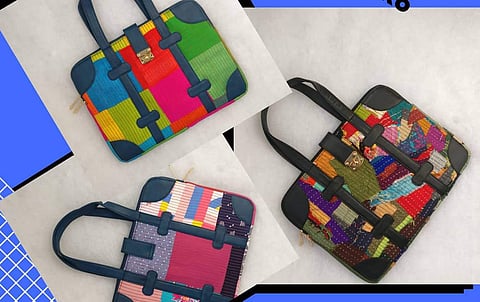

What can a woman with a Home Science degree do anyway? said people with a snicker. It was that notion, and that expression, that Bhavini N Parikh wanted to wipe out. In 1990, she started with a toy library and then even took tuitions in the art of napkin-folding and such but what really clicked was something entirely different.
The 53-year-old's sister was a merchandiser and Mumbai-based Bhavini got ‘the’ idea from her, of approaching manufacturing units and doing embroidery work for them. And she did this along with roping in her maid and other underprivileged women as well. Today, their empire (yes, that's the only way to describe them) has grown into something else. So much so that they were recognised by Startup India just a week ago.
How it began
Entre, Bunko Junko. Started in 2007, the model is that they gather scrap and waste clothes and fabric from tailors and manufacturing units and come up with their own products — from jackets, pullovers, necklaces, belts, there is so much they offer. "My vision was two-fold, empowering women and focusing on environmental sustainability," explains the innovator who has over 29 years of experience in the clothing industry.
Before the lockdown, they had as many as 1,500 women working in Mumbai and Gujarat, but now, due the pandemic, many of them have gone back home and the numbers are down. But the model remains the same and the entrepreneur who pursued Home Science from Sir Vithaldas Thackersey College of Home Science, takes us through it. The scraps are segregated by hand into fabrics, colour and other categories. "Then, after inputs from me and two to three freelance designers, the fabric is stitched aesthetically, putting together two or three patterns that go well together and then, the cloth is cut," she explains. The garments or accessories are stitched from that very cloth and the results are quirky, edgy and very, very different products.
A pursue from Bunko Junko | (Pic: Bunko Junko)
Easier said than done
And if you are thinking, 'That's it?', think again. Scraps come in different sizes and designs - to coordinate and stitch them together in a fashionable way is not an easy task. This is why segregation, which happens at her own manufacturing unit, is the most important part of the job. But their products and efforts have found lots of love in the various exhibitions they have exhibited them at. And, of course, there are the online sales.
"Why limit the skill to ladies?" Bhavini asked herself and just last year, she started visiting villages inside Sanjay Gandhi National Park and taught the children some of her skills over one month, on every Sunday. "They made such pretty fairy lights. I am hopeful that someday, what they learnt will be useful to them," she says.
And in the future too, Bhavini wants to scale the teaching up. "I want to offer vocational training in government schools situated in villages. Between dyeing and printing, there is so much to learn," she says and smiles.
For more on them, check out bunkojunko.com
